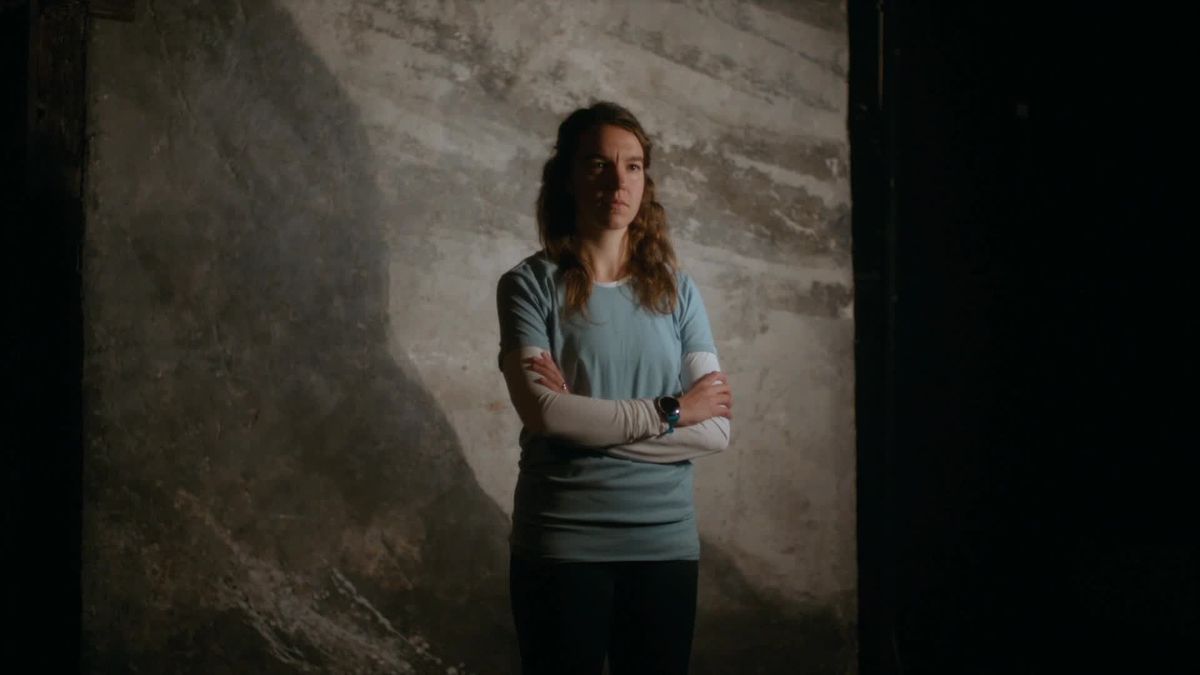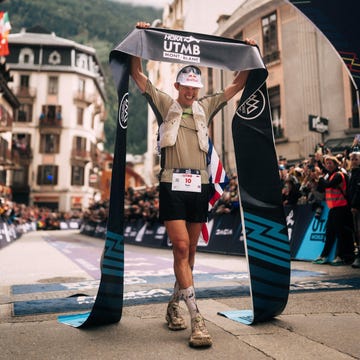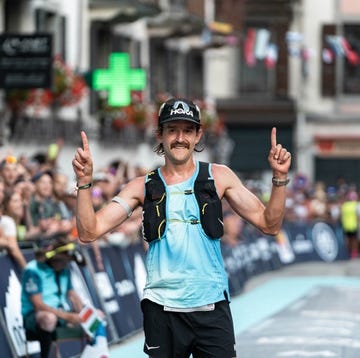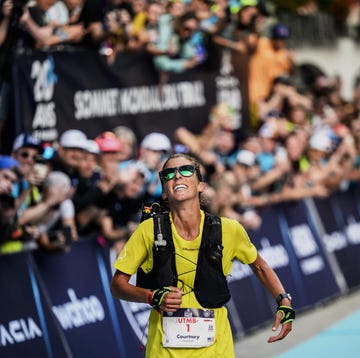How do you train for a 100-mile race? If you’re American ultrarunner Camille Herron, you train for one 100 miler by racing two other 100-milers. ‘February’s Jackpot 100 Ultra was actually my third 100-miler since October,’ she tells Runner’s World. ‘I've been running 100-milers every two months then recovering and coming back again.’
The tactic clearly works – at the Jackpot 100 in the arid Nevada desert with the Vegas Strip mere minutes away, Herron made global headlines by winning the race outright. But she didn't merely take victory – she also smashed her own record for the fastest ever 100 miles run by a woman (12:41:11, beating her previous record by 1min 29sec), the distance covered in 12 hours (152.8km) and the world record for fastest 50 miles in her age group 40-44 (6:08:24).
‘I went into the race with an open mind, thinking maybe I could run under 13 hours and if I'm in a position to break my world records then I'm gonna go for it.’
What everyone's reading
That’s exactly what she did, racing an average of 7.37 a mile for 100 miles around the 1.17-mile loop, with her last three miles being closer to 7min-mile pace once she realised the world record was within her grasp.
So how did Herron achieve this superhuman feat? We spoke to her to find out how a record-breaker trains, races and wins events like these, all while running for 12 hours with a huge grin on her face.
Don’t go too long in training
To prepare for the race, Herron ran around 120-130 miles per week. ‘I focus on feeling good,’ she says. ‘I have a background as a marathoner [with a PB of 2:37], so I’ve kept my marathon training approach as an ultrarunner.’ This makes her something of an outlier in the ultra world, as it means she isn’t doing extreme long runs. ‘I just run twice a day, with one or two speed sessions a week.’
But here’s the surprising part: her longest runs are a maximum of 18 to 22 miles, which she does once or twice a month. ‘As I get older, I focus more on feeling good and working with my body. I’m not trying to bust it out every weekend. I’ve found that when I do a lot of long runs and go too far it makes me more tired.’
Easy days mean easy
‘I take my easy days easy – really easy,’ she says. ‘Most of my easy days are around 8.30 to 9-min mile pace. I focus on running with purpose every day, and so my easy days are meant for recovery and aerobic development.’
This is mixed in with speed days where she pushes herself hard, attempts to develop her lactate threshold and build her fast-twitch fibres in order to maintain her relentlessly fast pace for 100 miles and continue to push human limits.
Race at 75 percent max heart rate
‘I do a lot of heart-rate training and I know that my 100-mile effort is equivalent to 75 percent of my max heart rate,’ says Herron. ‘That's equivalent to a steady long-run pace. So I practise that on my long runs to get a sense of what it feels like.’
One of the last workouts she did before the Jackpot 100 was 20 minutes at 75 percent max heart rate to dial herself into that effort. ‘I focus mentally on what it feels like and running at that effort.’
Be a ‘Steady Freddy’
Being one of the top ultrarunners in the world has resulted in an unexpected problem for Herron: ‘Everyone expects me to be up with the top men now,’ she says. As a result, she’s changed her tactics at the start of races. ‘I've been letting the top men go, as that they tend to go out too fast. As a woman, it doesn’t suit me to go out with them. For me, it’s better to be a ‘Steady Freddy’ and hit a more consistent pace throughout the race with the mindset that I'm going to catch them later.’
As most runners know, this is not an easy thing to do. ‘I want to go with the frontrunners, but at the same time I need to run the best race for me and work with my own physiology. And that’s made a difference in recent races.’
Not least with the Jackpot 100, where Arlen Glick led the race until around mile 80, when Herron caught and overtook him. ‘I believe that I look and feel stronger than the men later in races, and so I don’t know if there's something to that. There are stories of women beating men and how we have better staying power, and I've definitely seen it when I’ve raced really good men. I want to see how close I can get to the men’s world record.’
Check your mineral intake
Last year, Herron reached a point where she was so tired that she’d hit the 30-mile point in a race and want to lay down and sleep. By all accounts, this was highly irregular, so she decided to investigate why this was happening. ‘I realised I needed to get my bloods checked, and that’s when I discovered I had an iron overload issue.’
As well as having too much iron in her blood, the tests also revealed she was lacking magnesium and vitamin B12. ‘I definitely don’t have deficits on eating food, but I needed to change my diet to work with my own physiology. I hooked up with a dietitian and she’s helped me change my diet to get my iron levels down.’
Following the changes, which included doing something called the ‘root cause protocol’, which Herron says involves taking ‘a weird concoction of things like bee pollen and camu powder’ and giving up beer, she now feels like an inferno’s been ignited inside her again. ‘It's pretty incredible. I’d encourage other runners to figure out your own health and your own formula, because your body needs to be healthy to perform at your best.’
Up the weights
Herron recently invested in a squat rack, which means she can squat and deadlift heavier weights during her two weekly sessions. This rack, she happily declares, has been life-changing. ‘I was in a car accident three years ago and I injured my back. As a result, I've had issues down the right side of my body, including hip and hamstring problems. Then someone suggested getting a squat rack as you can go heavier.’
Up to that point, Herron had been doing free weights and single-leg workouts. ‘With the squat rack, I realised I actually like going heavier. It has the same goal-oriented mentality of constantly trying to improve and going up in weight, and it just feels good on my body. I wouldn't say I’m going super-heavy – I’m not gonna end up like Rocky Balboa.’
She adds that it’s helped to unravel the kinks she had on the right side of her body, and feels it’s crucial that as she gets older, especially as a woman, she maintains her musculoskeletal health. ‘It works my hips and their mobility, which means I’ve been able to maintain my speed just by being physically stronger. So I can sustain the pace for longer and maybe catch the men towards the end.’
Do brutal training runs to channel during the race’s dark moments
What do you do when you hit rock bottom during a 100-mile race? If you’re Herron, you take inspiration from your most strenuous, soul-sapping training runs. ‘I do a hard run in training, in fact I did it 10 days before the Jackpot 100, where I climb a really steep mountain. It’s absolutely gruelling – the hardest thing in the world. So in a 100-mile race, when I hit 80 miles, I’m thinking about how I feel when I’m climbing that mountain, and it makes me think, “I got this. I can do this. I've done this in training.”’
When life give you lemons, make lemonade
Herron lives by this proverb – not literally, although lemonade will definitely help you during a 100-miler– especially during races. ‘Even if I’m in my worst state at 80 miles and I’m in dire pain, I’ll be smiling and pushing through. This is one of my greatest strengths – that I’m a naturally happy, mentally strong person.’
Be proud of your age
Ageing used to worry Herron, but as she recently hit 40 and is getting faster, stronger and mentally wiser, she’s now excited to see what’s ahead. ‘I feel like I’m like a fine wine. I’m finding that the longer I go, my body is physically stronger. That’s why ultra-running suits older runners, especially women, as we’re developing that physical and mental strength to sustain our speed. I just want to keep going as long as I can and keep raising the bar and human limits.’
Use science when it comes to fuelling
‘I try to follow what the science recommends, which is 60-90g of carbohydrates per hour while racing,’ she says. ‘For me, that’s a gel with water every 30 minutes and then sipping sports drink in-between. I find that if I hit the low end of that 60g, that feels really good to me.’
Later in the race, however, things usually change. ‘I tend to hit a point where I start to want more calories and that’s when I add things like soda and maybe a non-alcoholic beer. This is where some people like to take solids. When it’s hot, I prefer a liquid-and-gel-based approach.’
Don’t underestimate the power of non-alcoholic beer
During the entire 12hrs 41mins that Herron was running, she stopped once, for just 15 seconds, in order to shotgun a non-alcoholic beer. ‘I'm always craving a beer during my long runs. I was about 75 miles in, really tired and I needed a boost. That’s the kind of mentality that you have for ultras – you’re trying to stay in tune with your body and think about what your body needs at certain points and whatever floats your boat to keep you feeling good.’
Neglect sleep at your peril
Sleep is something that Herron has been working on over the last year in order to recover properly from training and improve as an athlete. ‘After I found out I was low in magnesium and that magnesium impacts your sleep I felt like my sleep had been erratic for a couple years,’ she says. ‘My brain is always churning, and I like to run late at night as well.’
Her daily two-hour afternoon nap also disrupts her sleep patterns. ‘Getting into a regular routine of going to bed at 11pm and waking at 6am has really helped me feel better and ensure my body’s resting and recovering well.’
Camille’s two top tips for running your first 100-miler
Get a coach
‘I've seen people step up into ultra-running and making the mistake of thinking they need to run mega-mileage and extreme long runs. I found that marathon training works just as well for ultra races. That’s how I’ve been able to break world records, maintain my leg speed and feel good. Me and my husband Conor are coaches, and that’s the philosophy that we want to instil in people – build their confidence to be able to go 100 miles. It’s definitely more chill than people think.’
Train on the terrain you’ll be racing on
‘Strength training is really important, especially for trail running. Being able to train on the surface you'll be racing on, whether it’s road or trail, helps develop muscles and physical strength. For example, if I haven’t run on trails for a while it takes practise to develop the footwork and connectivity to be able to propel myself without tripping on rocks and roots.’














